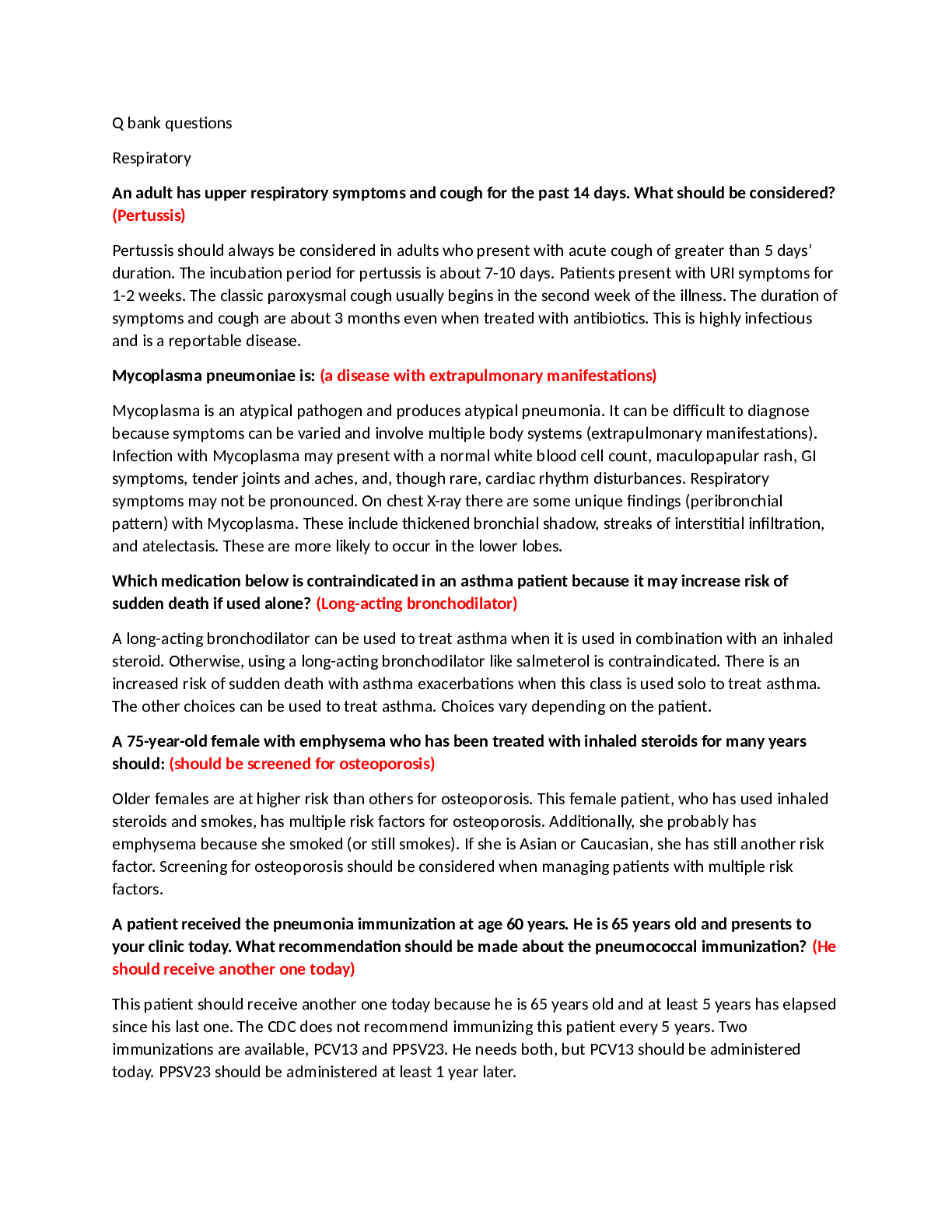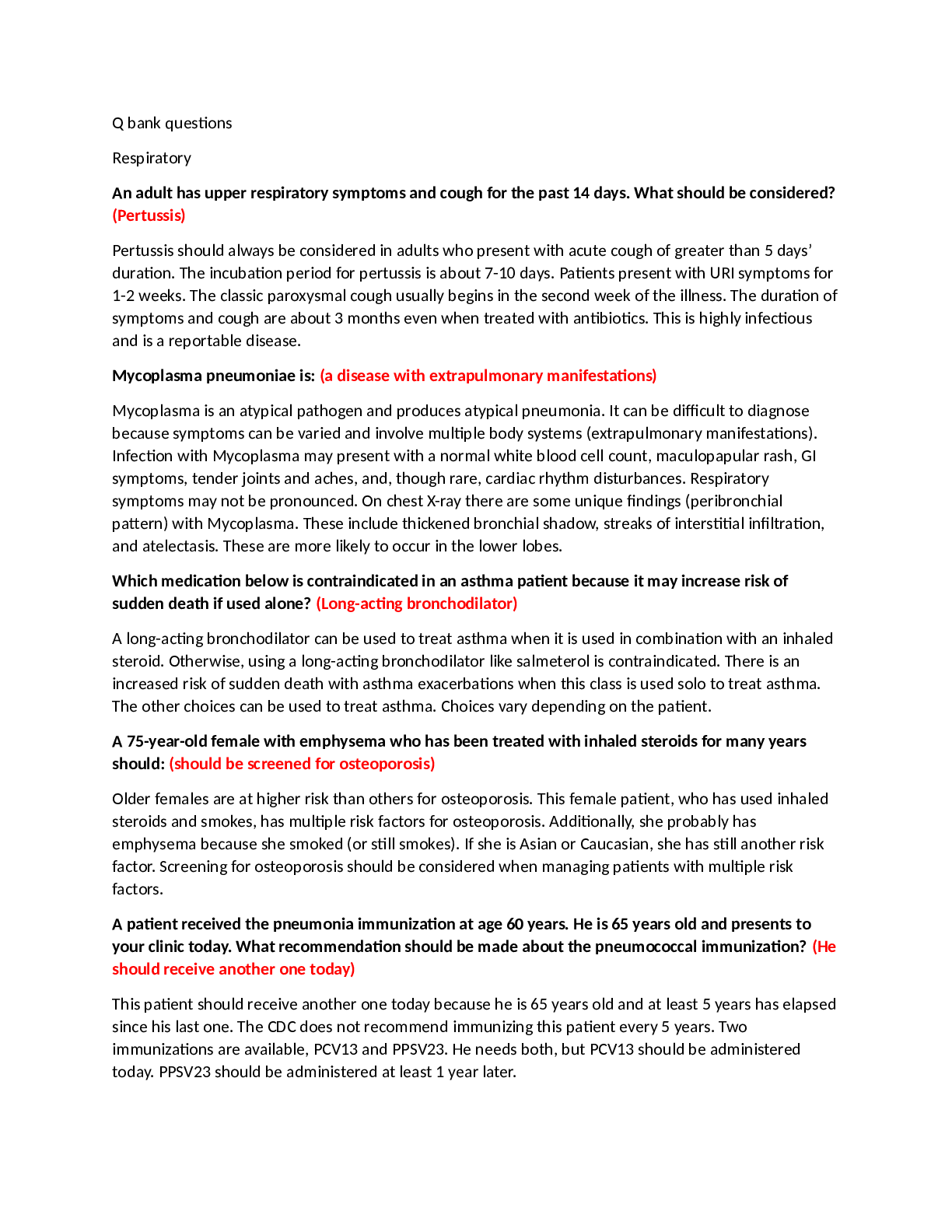Q bank questions
Respiratory
An adult has upper respiratory symptoms and cough for the past 14 days. What should be considered?
(Pertussis)
Pertussis should always be considered in adults who present with acute cough of greater than 5 days’
duration. The incubation period for pertussis is about 7-10 days. Patients present with URI symptoms for
1-2 weeks. The classic paroxysmal cough usually begins in the second week of the illness. The duration of
symptoms and cough are about 3 months even when treated with antibiotics. This is highly infectious
and is a reportable disease.
Mycoplasma pneumoniae is: (a disease with extrapulmonary manifestations)
Mycoplasma is an atypical pathogen and produces atypical pneumonia. It can be difficult to diagnose
because symptoms can be varied and involve multiple body systems (extrapulmonary manifestations).
Infection with Mycoplasma may present with a normal white blood cell count, maculopapular rash, GI
symptoms, tender joints and aches, and, though rare, cardiac rhythm disturbances. Respiratory
symptoms may not be pronounced. On chest X-ray there are some unique findings (peribronchial
pattern) with Mycoplasma. These include thickened bronchial shadow, streaks of interstitial infiltration,
and atelectasis. These are more likely to occur in the lower lobes.
Which medication below is contraindicated in an asthma patient because it may increase risk of
sudden death if used alone? (Long-acting bronchodilator)
A long-acting bronchodilator can be used to treat asthma when it is used in combination with an inhaled
steroid. Otherwise, using a long-acting bronchodilator like salmeterol is contraindicated. There is an
increased risk of sudden death with asthma exacerbations when this class is used solo to treat asthma.
The other choices can be used to treat asthma. Choices vary depending on the patient.
A 75-year-old female with emphysema who has been treated with inhaled steroids for many years
should: (should be screened for osteoporosis)
Older females are at higher risk than others for osteoporosis. This female patient, who has used inhaled
steroids and smokes, has multiple risk factors for osteoporosis. Additionally, she probably has
emphysema because she smoked (or still smokes). If she is Asian or Caucasian, she has still another risk
factor. Screening for osteoporosis should be considered when managing patients with multiple risk
factors.
A patient received the pneumonia immunization at age 60 years. He is 65 years old and presents to
your clinic today. What recommendation should be made about the pneumococcal immunization? (He
should receive another one today)
This patient should receive another one today because he is 65 years old and at least 5 years has elapsed
since his last one. The CDC does not recommend immunizing this patient every 5 years. Two
immunizations are available, PCV13 and PPSV23. He needs both, but PCV13 should be administered
today. PPSV23 should be administered at least 1 year later.
Which of the following medications should be used cautiously in a patient who has asthma? (Timolol
ophthalmic drops)
Timolol is a beta blocker. This class of medications can precipitate bronchoconstriction in patients who
have asthma. Even though timolol is being administered in the eye, it is absorbed through mucous
membranes and can exert systemic effects. Beta blockers should be avoided in patients with asthma and
used cautiously in patients with COPD. The other medications listed have no specific contraindications
for patients with asthma.
The most common symptom associated with acute bronchitis is: (Cough)
Fever (temp > 101°F) is an unusual symptom associated with acute bronchitis. Cough is the most
common symptom associated with acute bronchitis. Purulent sputum is identified in more than 50% of
patients with acute bronchitis. The color imparted to the sputum is usually due to sloughing of epithelial
cells, not bacterial infection. Concurrent upper respiratory symptoms are typical of acute bronchitis.
Pharyngitis is common.
Mild persistent asthma is characterized by: (symptoms occurring more than twice weekly)
Mild persistent asthma is characterized by symptoms that occur more than twice weekly but not daily; or
3-4 nocturnal awakenings per month due to asthma. It is treated with an inhaled steroid daily, and a
bronchodilator PRN for exacerbations. If symptoms occur more than twice weekly, therapy should be
stepped up. Generally, a long-acting bronchodilator is added to the steroid when therapy is stepped up.
The chest circumference of a 12 month-old is: (equal to head circumference)
The chest circumference is not routinely measured at well-child visits, but is assessed if there is concern
about the circumference of either the head or the chest. An exception to this observation can occur in
premature infants where the head grows very rapidly. Normally, the head exceeds the chest
circumference by 1-2 cm from birth until 6 months. Between 6 and 24 months the head and chest
circumference should be about equal and by 2 years of age the chest should be larger than the head. The
chest circumference is measured at the nipple line.
A patient with cough and fever is found to have infiltrates on chest x-ray. What is his likely diagnosis?
(Pneumonia)
The finding of infiltrates on chest x-ray, in conjunction with clinical findings of fever and cough, should
direct the examiner to consider pneumonia as the diagnosis. Other common clinical findings with
pneumonia include chest pain, dyspnea, and sputum production. Though not common, some patients
with pneumonia exhibit gastrointestinal symptoms like nausea, vomiting, and diarrhea.
An uncommon symptom associated with acute bronchitis is: (temperature > 101°F)
Fever is an unusual symptom associated with acute bronchitis. Cough is the most common symptom
associated with acute bronchitis. Purulent sputum is identified in more than 50% of patients with acute
bronchitis. The color imparted to the sputum is usually due to sloughing of epithelial cells, not bacterial
infection. Concurrent upper respiratory symptoms are typical of acute bronchitis. Pharyngitis is common
within the first 3 days of the illness.
Patients who have cough-variant asthma: (all exhibit cough)
Read More


